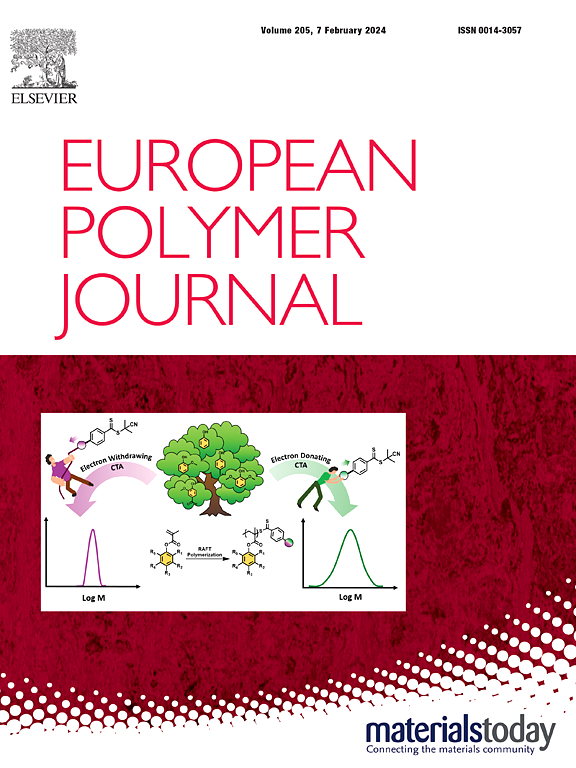Flexible ammonium surfactants cross-linked alginate fibers with fluorescence, high mechanical performances, acid-resistance and wide temperature tolerance
IF 5.8
2区 化学
Q1 POLYMER SCIENCE
引用次数: 0
Abstract
The combination of multiple physical properties is of great importance for the development of high performance biomaterials. It is remaining a challenge to fabricate polysaccharides-based fibers with simultaneously gaining high strength, high toughness and fluorescence. In this work, a type of high performance fibers (Alg-TPEA) is designed by ionically complexing natural alginate with a tetraphenylethene-containing surfactant (TPEA). Working as flexible contact points, TPEA could efficiently cross-link the polysaccharide chains of alginate, which creates a cohesive network for improving the plastic strain performance of fibers, leading to Alg-TPEA fibers with breaking strength of 900.05 MPa and toughness of 72.50 MJ m−3. A joint use of other flexible surfactants could further improve the toughness to 118.20 MJ m−3. Alg-TPEA fibers exhibit strong tolerance to extreme conditions and strong resistance to static and dynamic impacts. The fluorescence property of Alg-TPEA fibers would facilitate some fine operations by giving easy detection. This work provides a new synthetic strategy for fabricating highly-strong and highly-tough fluorescent biomaterials from natural biomacromolecules.

柔性铵表面活性剂交联海藻酸盐纤维具有荧光、高机械性能、耐酸和宽耐温性能
多种物理性质的结合对高性能生物材料的开发具有重要意义。制备高强度、高韧性和荧光性的多糖基纤维仍然是一个挑战。本研究将天然海藻酸盐与含四苯乙烯表面活性剂(TPEA)离子络合,设计了一种高性能纤维(Alg-TPEA)。TPEA作为柔性接触点,可以有效地交联海藻酸盐的多糖链,形成一个内聚网络,提高纤维的塑性应变性能,使Alg-TPEA纤维的断裂强度达到900.05 MPa,韧性达到72.50 MJ m−3。与其他柔性表面活性剂联合使用可进一步将韧性提高到118.20 MJ m−3。Alg-TPEA纤维对极端条件具有很强的耐受性,对静态和动态冲击具有很强的抵抗力。Alg-TPEA纤维的荧光特性使其易于检测,有利于一些精细操作。本研究为利用天然生物大分子制备高强度、高韧性荧光生物材料提供了一种新的合成策略。
本文章由计算机程序翻译,如有差异,请以英文原文为准。
求助全文
约1分钟内获得全文
求助全文
来源期刊

European Polymer Journal
化学-高分子科学
CiteScore
9.90
自引率
10.00%
发文量
691
审稿时长
23 days
期刊介绍:
European Polymer Journal is dedicated to publishing work on fundamental and applied polymer chemistry and macromolecular materials. The journal covers all aspects of polymer synthesis, including polymerization mechanisms and chemical functional transformations, with a focus on novel polymers and the relationships between molecular structure and polymer properties. In addition, we welcome submissions on bio-based or renewable polymers, stimuli-responsive systems and polymer bio-hybrids. European Polymer Journal also publishes research on the biomedical application of polymers, including drug delivery and regenerative medicine. The main scope is covered but not limited to the following core research areas:
Polymer synthesis and functionalization
• Novel synthetic routes for polymerization, functional modification, controlled/living polymerization and precision polymers.
Stimuli-responsive polymers
• Including shape memory and self-healing polymers.
Supramolecular polymers and self-assembly
• Molecular recognition and higher order polymer structures.
Renewable and sustainable polymers
• Bio-based, biodegradable and anti-microbial polymers and polymeric bio-nanocomposites.
Polymers at interfaces and surfaces
• Chemistry and engineering of surfaces with biological relevance, including patterning, antifouling polymers and polymers for membrane applications.
Biomedical applications and nanomedicine
• Polymers for regenerative medicine, drug delivery molecular release and gene therapy
The scope of European Polymer Journal no longer includes Polymer Physics.
 求助内容:
求助内容: 应助结果提醒方式:
应助结果提醒方式:


